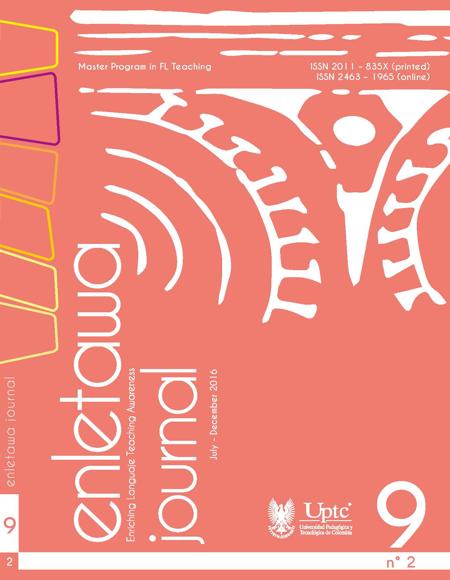Creating Multimodal Texts Online to Improve Young Adults’ English Skills at Two State Institutions

Resumen
This paper aims to describe the creation of multimodal texts as a pedagogical strategy implemented through the use of ICT tools in two state institutions in the Colombian province of Santander. After analyzing teaching practices, it was observed that written texts were usually approached in a linear manner without taking into consideration other text modes, which may lead students to lose interest in literacy practices. Accordingly, an action research was conducted following a qualitative paradigm based on a descriptive-interpretative methodology. The research results suggested learner improvement resulting from the use of ICT for educational purposes, learning English through the implementation of integrated skills, and working collaboratively. It was also concluded that when creating multimodal texts, it is important to bear in mind both: students’ perceptions of the world and the role of the teacher as a facilitator of ICT tools for academic purposes in virtual learning environments.
Palabras clave
Blended learning, Learning environments, Multimodal texts, Friendship, and Love relations
Referencias
- Ariew, R., &Ercetin, G. (2004). Exploring the Potential of Hypermedia
- Annotations for Second Language Reading. Computer Assisted Language Learning,17 (2), 237–259. doi0.1080/0958822042000334253
- Barton, D., Hamilton, M., &Ivanič, R. (2000). Literacy Practices. In D.
- Barton, M. Hamilton & R. Ivanič (Eds.), Situated Literacies: Reading and Writing in Context (pp. 7-15). London: Routledge.
- Bear, R., Estreem, H., Fredricksen, J.E., & Shepherd, D. (2014). Participation and Collaboration in Digital Spaces: Connecting High school and College Writing experiences. In R. McClure &J.P.Purdy(Eds.), The Next Digital Scholar: A fresh Approach to the
- Common Core State Standards for Research and Writing(pp.131-174). Silver Spring, MA: ASIS&T.
- Cope, B., &Kalantzis, M. (2000). The beginnings of an idea. In B.
- Cope & M. Kalantzis (Eds.), Multiliteracies: Literacy Learning and the
- Design of Social Futures, (pp. 3-8). London: Routledge.
- Colombia. Ministerio de Educación Nacional [MEN] (2014). Colombia Very Well. Retrieved from/http://www.colombiaaprende.edu.co/html/micrositios/1752/articles-343287_recurso_1.pdf
- Colegio Trinidad Camacho Pinzón. (2016). Plan de asignatura Inglés-2016. Unpublished document.
- Elliot, R., &Timulak, L. (2005). Descriptive and interpretive approaches to qualitative research. In J. Miles & P. Gilbert (Eds.), Handbook of Research Methods for Clinical and Health Psychology (pp. 147-160). Oxford, UK: Oxford University Press.
- Garrison, R., &Kanuka, H. (2004). Blended learning: Uncovering its transformative potential in higher education. Internet and Higher Education, 1, 95–105. DOI: https://doi.org/10.1016/j.iheduc.2004.02.001
- Greene, S., Cunningham, S., Moor, P. (2013). Cutting Edge Elementary: Third edition. UK: Pearson.
- Jewitt, C. (2008). Multimodality and Literacy in School Classrooms. Review of Research in Education, 32, 241–267.doi:10.3102/0091732X07310586 DOI: https://doi.org/10.3102/0091732X07310586
- Johnson, R. B., & Christensen, L. B. (2004). Educational research: Quantitative, qualitative, and mixed approaches. Boston, MA: Allyn and Bacon.
- Hofmann,J., & Miner, N.(2009).Tailored Learning: Designing the Blend That Fits. Alexandria, VA: ASTD.
- Kress, G., & van Leeuwen, T. (1996). Reading images: The grammar of visual design. London: Routledge.
- Lai, R. E. (2011). Collaboration. A literature Review. Retrieved from: http://images. pearsonassessments.com/images/tmrs/Collaboration-Review.pdf
- Lankshear, C., &Knobel, M. (2003). New literacies: Changing knowledge and classroom learning. Buckingham, UK: Open University Press.
- Little Bird Tales. (2016). Retrieved from: https://littlebirdtales.com/about/default/
- Maintz, J. (2009). Blending Spaces: Actor-network Interactions of an Internet-based E-learning Course. Hamburg, Germany: LIT Verlag.
- Prensky, Mark. (2001).Digital Natives, Digital Immigrants. Retrieved from: http://www. marcprensky.com/writing/Prensky%20-20Digital%20Natives,%20 Digital%20 Immigrants%20-%20Part1.pdf
- Rossett, A. (ed.) (2002). The ASTD E-Learning Handbook. New York: McGraw-Hill.
- Rowsell, J.,& Walsh, M. (2011). Rethinking Literacy Education in New Times: Multimodality, Multiliteracies, & New Literacies. Brock Education, 21 (1), 53-62. DOI: https://doi.org/10.26522/brocked.v21i1.236
- Rovai, A.P.,& Jordan,H.M. (2004). Blended Learning and Sense of Community: A comparative analysis with traditional and fully online graduate courses. IRRODL, 5(2), 1-13.doi: 10.19173/irrodl. v5i2.192 DOI: https://doi.org/10.19173/irrodl.v5i2.192
- Schrage, M. (1995). No more teams. New York, NY: Doubleday.
- Snowdon, D., Churchill, E.F., & Munro, A.J. (2000). Collaborative Virtual Environments: Digital spaces and places for interaction for CSCW: An Introduction. In D.Snowdon, E.F. Churchill & A.J. Munro (Eds.), Collaborative Virtual Environments: Digital places and spaces for interaction(pp. 3-20). London, UK: Springer Verlag. DOI: https://doi.org/10.1007/978-1-4471-0685-2_1
- Tripp, D. (2005). Action research: a methodological introduction. Retrieved from: http://www.scielo.br/pdf/ep/ v31n3/en_a09v31n3.pdf
- Unsworth, L. (2001). Teaching Multiliteracies across the Curriculum. Buckingham: Open University Press.
- Vaarala, H., &Jalkanen, J. (2010). Changing spaces, expanding mindsets: towards L2 literacies on a multimodal reading comprehension course. LanguageValue, 2 (1), 68-99.